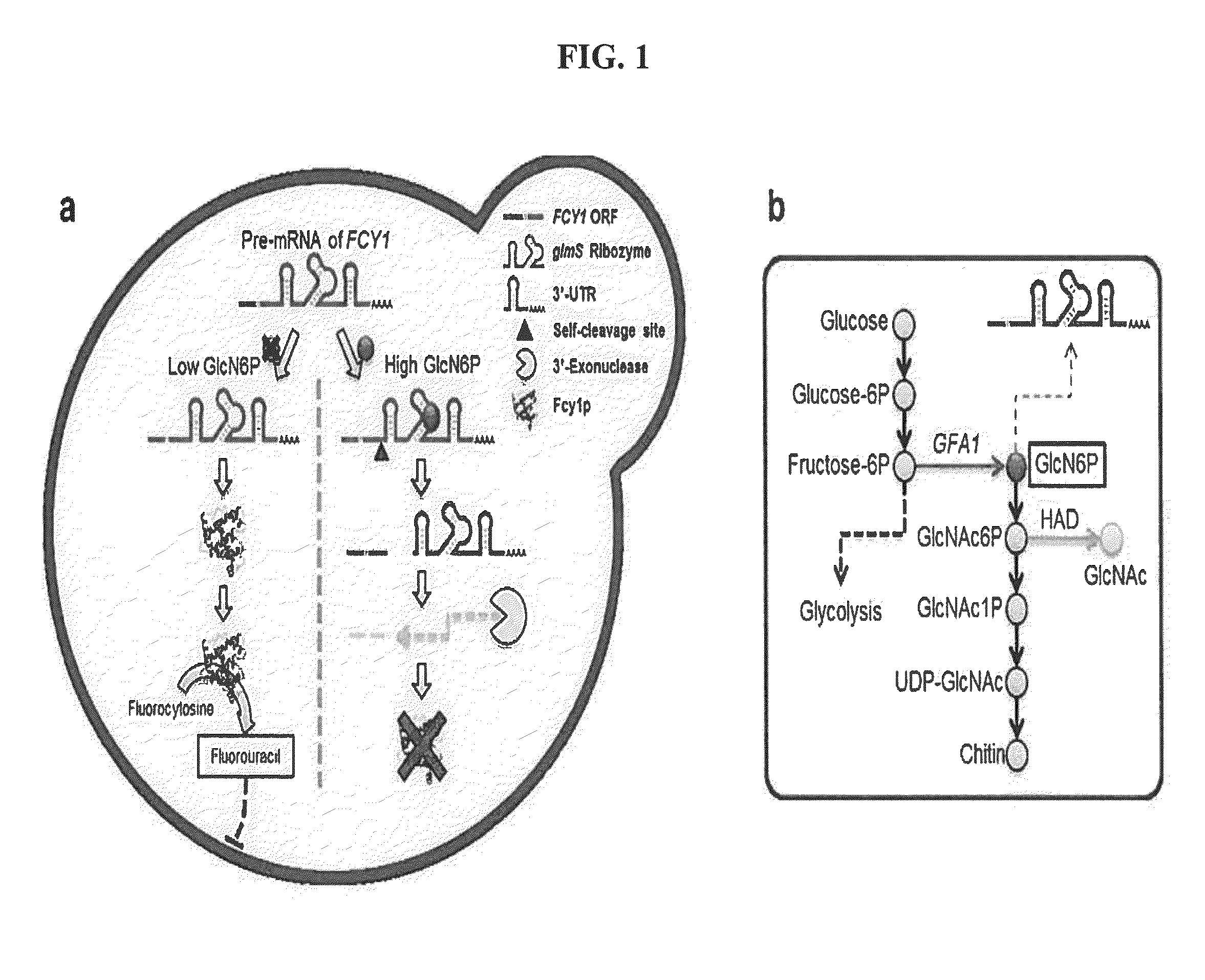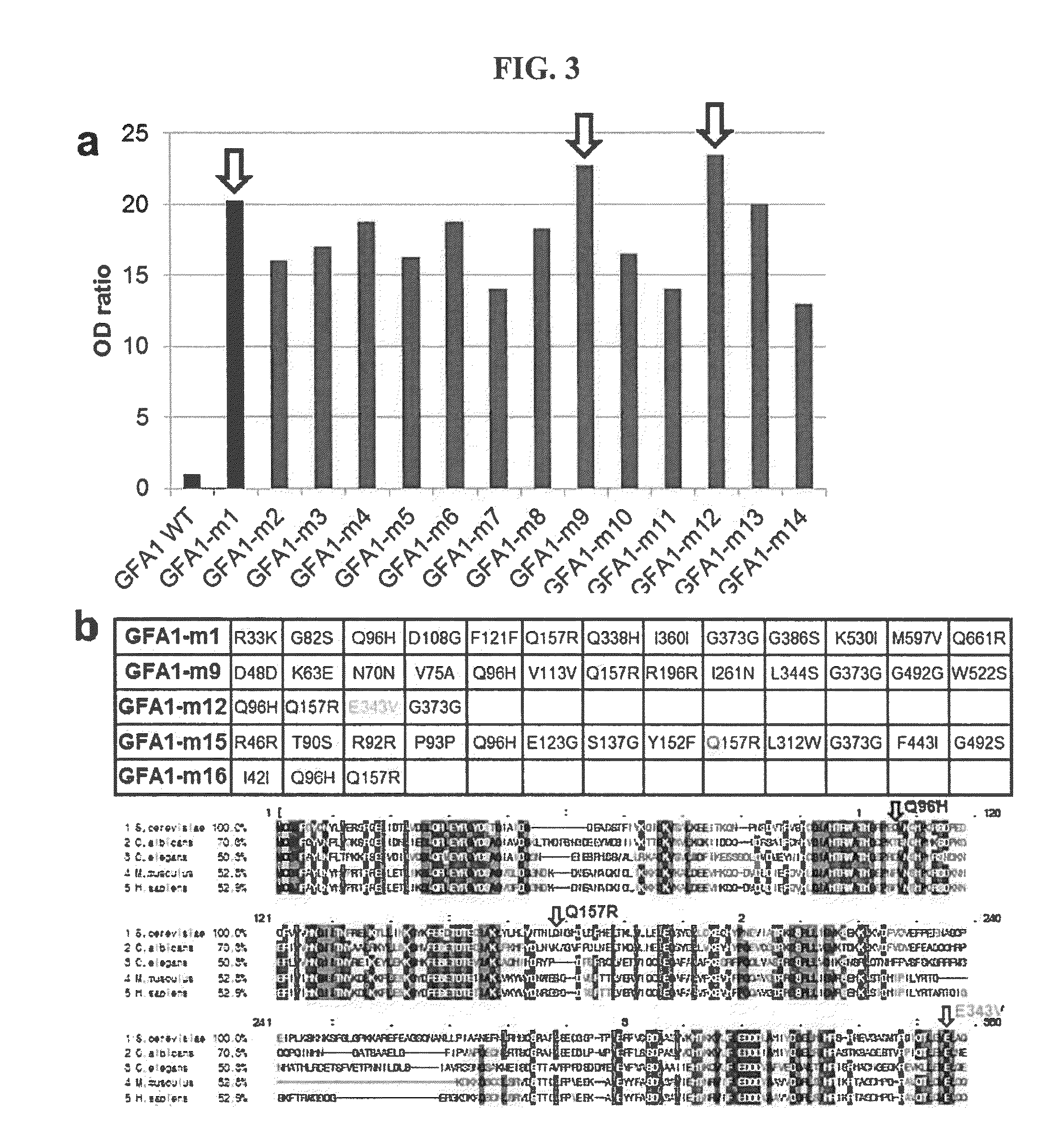Method for screening mutant microorganism overproducing target metabolite using synthetic suicide genetic circuit
- Summary
- Abstract
- Description
- Claims
- Application Information
AI Technical Summary
Benefits of technology
Problems solved by technology
Method used
Image
Examples
example 1
Construction of Suicide Riboswitch to be Introduced into Yeast (Saccharomyces cerevisiae) BY4742 Strain
[0062]1-1: Construction of Suicide Riboswitch Using glmS Ribozyme
[0063]First, in order to clone a glmS ribozyme (Nucleic Acids Res. 2006 February 7; 34(3):968-75, “Core requirements for glmS ribozyme self-cleavage reveal a putative pseudoknot structure”) using a Klenow fragment (Takara, Shiga, Japan), two DNA primers (GAAATGTAGTTGACGAGGAG / CTCCTCGTCAACTACATTTC) having an overlap of 20 base pairs were added and annealed at room temperature. The annealed primers were incubated together with a Klenow fragment for filling the 3′ end. After incubation for 1 hour, the primer complex, containing a glmS ribozyme sequence and filled at the 3′ end, was cut with a restriction enzyme and ligated into a plasmid. Using the plasmid having a URA3 cassette following the glmS ribozyme sequence as a template, amplification was performed by a polymerase chain reaction (PCR). In order to introduce the a...
example 2
Construction of GFA1 Mutant Library and HAD Phosphatase Library
[0071]Using error-prone PCR that generates random point mutations, a GFA1 mutant library of yeast (Saccharomyces cerevisiae) was produced. Specifically, yeast GFA1 was cloned into a p415TEF plasmid, which was then used as a template for error-prone PCR using a Genemorph II Random Mutagenesis kit (Agilent, CA, USA). The PCR amplification product was ligated into a p415TEF plasmid using Mighty Mix (Takara), and the plasmid was transformed into highly competent E. coli DH5α HIT competent cells (RBC, Banqiao City, Taipei County, Taiwan) to maximally recover the plasmid.
[0072]23 E. coli HAD phosphatases excluding HAD11 were cloned into p413GPD plasmids. For production of a HAD phosphatase library, the plasmids comprising the HAD phosphatase-encoding genes were separated and then mixed together.
example 3
Construction and Screening of GFA1 Mutant Library and BAD Phosphatase Library
[0073]Plasmids encoding GFA1 mutants or HAD phosphatases were introduced into a BY4742 FGU (BY4742 containing the glmS suicide riboswitch) strain. Specifically, a BY4742 FGU strains were cultured in YEPD medium (1% yeast extract, 2% peptone, 2% glucose) at 30° C. For transformation, exponentially growing cells were collected by centrifugation at 250 rpm. The GFA1 mutant library was transformed into the BY4742 FGU strain, and the transformants were screened on an SD-LEU-URA medium (2% glucose, 0.67% yeast nitrogen base without amino acids, 0.67 g / L CSM-LEU-URA dropout mixture) plate.
[0074]The HAD phosphatase library was transformed into the GFA1-m12 strain showing the highest efficiency, and was screened on an SD-HIS-LEU-URA medium (2% glucose, 0.67% yeast nitrogen base without amino acids, 0.60 g / L CSM-HIS-LEU-URA dropout mixture) plate.
PUM
| Property | Measurement | Unit |
|---|---|---|
| Strain point | aaaaa | aaaaa |
Abstract
Description
Claims
Application Information
 Login to View More
Login to View More - R&D
- Intellectual Property
- Life Sciences
- Materials
- Tech Scout
- Unparalleled Data Quality
- Higher Quality Content
- 60% Fewer Hallucinations
Browse by: Latest US Patents, China's latest patents, Technical Efficacy Thesaurus, Application Domain, Technology Topic, Popular Technical Reports.
© 2025 PatSnap. All rights reserved.Legal|Privacy policy|Modern Slavery Act Transparency Statement|Sitemap|About US| Contact US: help@patsnap.com



